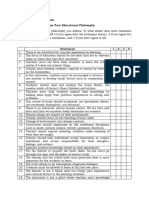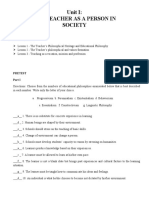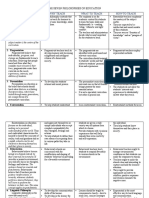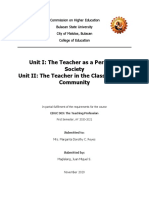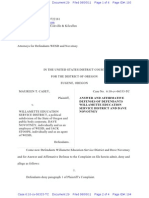0 ratings0% found this document useful (0 votes)
27 viewsEDUC 3 LECTURE SEVEN PHILOSOPHIES of EDUCATION
EDUC 3 LECTURE SEVEN PHILOSOPHIES of EDUCATION
Uploaded by
Alexie Anne MariñoThe document discusses seven philosophies of education: Constructivism, Essentialism, Progressivism, Perennialism, and Existentialism. Constructivism sees the goal of education as developing independent, self-motivated learners by teaching them how to learn, think critically, and construct their own understandings. Essentialism focuses on mastery of core academic content and basic skills. Progressivism aims to develop enlightened citizens by making education relevant to students' lives and needs through experiential learning. Perennialism emphasizes developing students' reasoning abilities through studying the humanities and great books. Existentialism provides students with choices to find self-directed learning.
Copyright:
© All Rights Reserved
Available Formats
Download as PDF, TXT or read online from Scribd
EDUC 3 LECTURE SEVEN PHILOSOPHIES of EDUCATION
EDUC 3 LECTURE SEVEN PHILOSOPHIES of EDUCATION
Uploaded by
Alexie Anne Mariño0 ratings0% found this document useful (0 votes)
27 views5 pagesThe document discusses seven philosophies of education: Constructivism, Essentialism, Progressivism, Perennialism, and Existentialism. Constructivism sees the goal of education as developing independent, self-motivated learners by teaching them how to learn, think critically, and construct their own understandings. Essentialism focuses on mastery of core academic content and basic skills. Progressivism aims to develop enlightened citizens by making education relevant to students' lives and needs through experiential learning. Perennialism emphasizes developing students' reasoning abilities through studying the humanities and great books. Existentialism provides students with choices to find self-directed learning.
Original Title
EDUC-3-LECTURE-SEVEN-PHILOSOPHIES-of-EDUCATION (1)
Copyright
© © All Rights Reserved
Available Formats
PDF, TXT or read online from Scribd
Share this document
Did you find this document useful?
Is this content inappropriate?
The document discusses seven philosophies of education: Constructivism, Essentialism, Progressivism, Perennialism, and Existentialism. Constructivism sees the goal of education as developing independent, self-motivated learners by teaching them how to learn, think critically, and construct their own understandings. Essentialism focuses on mastery of core academic content and basic skills. Progressivism aims to develop enlightened citizens by making education relevant to students' lives and needs through experiential learning. Perennialism emphasizes developing students' reasoning abilities through studying the humanities and great books. Existentialism provides students with choices to find self-directed learning.
Copyright:
© All Rights Reserved
Available Formats
Download as PDF, TXT or read online from Scribd
Download as pdf or txt
0 ratings0% found this document useful (0 votes)
27 views5 pagesEDUC 3 LECTURE SEVEN PHILOSOPHIES of EDUCATION
EDUC 3 LECTURE SEVEN PHILOSOPHIES of EDUCATION
Uploaded by
Alexie Anne MariñoThe document discusses seven philosophies of education: Constructivism, Essentialism, Progressivism, Perennialism, and Existentialism. Constructivism sees the goal of education as developing independent, self-motivated learners by teaching them how to learn, think critically, and construct their own understandings. Essentialism focuses on mastery of core academic content and basic skills. Progressivism aims to develop enlightened citizens by making education relevant to students' lives and needs through experiential learning. Perennialism emphasizes developing students' reasoning abilities through studying the humanities and great books. Existentialism provides students with choices to find self-directed learning.
Copyright:
© All Rights Reserved
Available Formats
Download as PDF, TXT or read online from Scribd
Download as pdf or txt
You are on page 1of 5
SEVEN
PHILOSOPHIES of WHY TEACH WHAT TO TEACH HOW TO TEACH
EDUCATION
Constructivists sees to develop The learners are taught how to The teacher provides
intrinsically motivated and learn. They are taught learning students with data or
independent learners adequately processes and skill such as searching, experiences that allow them
equipped with learning skills for critiquing and evaluating to hypothesize, predict,
them to be able construct information, relating these pieces of manipulate objects, pose
knowledge and make meaning of information, reflecting on the same, questions, research,
them. making meaning out of them, investigate, imagine, and
CONSTRUCTIVISM drawing insights, posing questions, invent.
researching and constructing new The constructivist classroom
knowledge out of these bits of is interactive.
information learned. It promotes dialogical
exchange of ideas among
learners and between
teacher and learners.
Teacher’s role is to facilitate
this process.
Knowledge isn’t a thing that can be simply deposited by the teacher into the empty minds of the learners.
POV: Constructivism Knowledge is constructed by learners through an active mental process of development.
The learners are the builders and creators of meaning and knowledge. Their minds are not empty.
Their minds are full of ideas waiting to be “midwifed” by the teacher with his/her skillful facilitating skills.
This philosophy contends that Essentialist programs are Essentialist teachers
teachers teach for learners to academically rigorous. The emphasis emphasize mastery of
acquire basic knowledge, skills and is on academic content for students subject matter.
values. Teachers teach “not to to learn the basic skills or the They are expected to be
ESSENTIALISM radically reshape society but rather fundamental r’s – reading, ‘riting, intellectual and moral
to transmit the traditional moral ‘rithmetic, right conduct – as these models of their students.
values and intellectual knowledge are essential to the acquisition of They are seen as “fountain”
that students need to become model higher or more complex skills of information and as a
citizens.” needed in preparation for adult life. “paragon of virtue.”
Essentialist curriculum includes the To gain mastery of basic
“traditional disciplines such as math, skills, teachers have to
natural science, history, foreign observe “core
language, and literature. requirements, longer school
day, a longer academic year.
Mastery of academic content as primary focus, teachers rely heavily on the use of prescribed textbooks, the
POV: Essentialism drill method and other methods that enable them to cover as much academic content as possible like the
lecture method.
There is a heavy stress on memorization and discipline.
Progressivist teachers teach to The progressivists are identified with Progressivist teachers
develop learners into becoming need-based and relevant curriculum. employ experiential
enlightened and intelligent citizens This is a curriculum that “responds methods.
of a democratic society. This group to students” needs and that relates They believe that one learns
of teachers teaches learners so they to students’ personal live and by doing.
may live life fully NOW not to experiences.” John Dewey – Father of
PROGRESSIVISM prepare them for adult life. Teachers expose students to many Progressivism, book leaning
new scientific, technological, and is no substitute for actual
social developments, reflecting the experience.
progressivist notion that progress Experiential teaching
and change are fundamental. method that progressivist
teachers heavily rely on is
the problem-solving
method.
Field trip, thought provoking
games, and puzzles.
“hands-on-minds-on-hearts-on”
POV: Progressivism Change is the only thing that does not change.
The subjects that are given emphasis in progressivist schools are the “natural and social sciences.”
Students solve problems in the classroom similar to those they will encounter outside of the schoolhouse.
We are all rational animals. Schools The perennialist curriculum is a Perennialist classrooms are
should therefore, develop the universal one on the view that all “centered around teachers”
PERENNIALISM students’ rational and moral powers. human beings possess the same Teachers apply whatever
According to Aristotle, if we neglect essential nature. It is heavy on the creative techniques and
the students’ reasoning skills, we humanities, on general education. It other tried and true
deprive them of the ability to use is not a specialist curriculum but methods which are believed
their higher faculties to control their rather a general one. There is less to be most conducive to
passions and appetites. emphasis on vocational and disciplining the students’
technical education. minds.
Students engaged in Socratic
dialogues, or mutual inquiry
sessions to develop an
understanding of history’s
most timeless concepts.
Philosopher Mortimer Adler claims that “Great Books of ancient and medieval as well as modern times are a
POV: Perennialism repository of knowledge and wisdom, a tradition of culture which must initiate each generation.”
The main concern of the Students are given a wide variety of Existentialist methods focus
existentialists is “to help students options from which to choose. on the individual. Learning is
understand and appreciate Students are afforded great latitude self-paced, self-directed.
themselves as unique individuals in their choice of subject matter. The It includes a great deal of
who accept complete responsibility humanities, however, are given individual contact with the
EXISTENTIALISM for their thoughts, feelings and tremendous emphasis to “provide teacher, who relates to each
actions.” students with vicarious experiences student openly and honestly.
The existentialist teacher’s role is to that will help unleash their own To help students know
help students define their own creativity and self-expression. themselves and their place
essence by exposing them to various in society, teachers employ
paths they take in life and by values clarification strategy.
creating an environment in which In the use of such strategy,
they freely choose their own teachers remain non-
preferred way. judgemental and take care
not to impose their values
on their students since
values are personal.
Vocational education is regarded as a means of teaching students about themselves and their potential than
POV: Existentialism earning a livelihood.
In art, existentialism encourages individual creativity and imagination more than copying and imitating
established models.
Behaviorist schools are concerned Behaviorists look at “people and or Ought to arrange
with the modification and shaping of other animals… as complex environmental conditions so
students’ behavior by providing for a combinations of matter that act only that students can make the
BEHAVIORISM favorable environment, since the y in response to internally or responses to stimuli.
believe that they are product of their externally generated physical Physical variables like light,
environment. They are after stimuli,” temperature, arrangement
students who exhibit desirable Behaviorist teachers teach students of furniture, size and
behavior in society. to respond favorably to various quantity of visual aids have
stimuli in the environment. to be controlled to get the
desired responses from the
learners.
Teachers ought to make the stimuli clear and interesting to capture and hold the learner’s attention.
POV: Existentialism They ought to provide appropriate incentives to reinforce positive responses and weaken or eliminate
negative ones. (Trespeces, 1995)
LINGUISTIC PHILOSOPHY To develop the communication skills The learners should be taught to The most effective way to
of the learner because the ability to communicate clearly - how to send teach language and
articulate, to voice out the meaning clear, concise messages and how to communication is the
and values of things that one obtains receive and correctly understand experiential way.
from his/her experience of life and messages sent. Make them experience
the world is the very essence of man. Communication takes place in three sending and receiving
(3) ways – verbal, nonverbal, and messages through verbal,
paraverbal. non-verbal and par-verbal
Verbal component refers to the manner.
content of our message, choice and Teacher should make the
arrangement of our words. This can classroom a place for the
be oral or written. interplay of minds and
Nonverbal component refers to the hearts.
message we send through our body The teacher facilitates
language. dialogue among learners and
Paraverbal component refers to how between him/her and
we say – the tone, pacing and his/her students because in
volume of our voices. the exchange of words there
is also an exchange of ideas.
POV: Linguistic Philosophy Teachers teach to develop in the learner the skill to send messages clearly and receive messages correctly.
There is need to teach learners to use language that is correct, precise, grammatical, coherent, and accurate
so that they are able to communicate clearly and precisely their thoughts and feelings.
There is need to teach the learners how to communicate clearly through non-verbal means and consistently
though para-verbal means.
Resource:
Bilbao, P.P., Corpuz, Corpuz, B. B., Llagas, A. T, Salandanan, G. G.(2018): The Teaching Profession OBE & PPST-Based: Lorimar Publishing Inc. Cubao, Quezon
City
You might also like
- Philosophy Theory of Truth Methodolog y To Arrive at The Truth Theory of What Is Available/ Good Goal of Teaching and LearningDocument4 pagesPhilosophy Theory of Truth Methodolog y To Arrive at The Truth Theory of What Is Available/ Good Goal of Teaching and LearningIan Dante Arcangeles73% (15)
- Challenge 3 Philophies of EducationDocument3 pagesChallenge 3 Philophies of EducationDiane RomeroNo ratings yet
- How to Teach Kids Anything: Create Hungry Learners Who Can Remember, Synthesize, and Apply KnowledgeFrom EverandHow to Teach Kids Anything: Create Hungry Learners Who Can Remember, Synthesize, and Apply KnowledgeNo ratings yet
- This Study Resource Was Shared Via: Unit 1: Global Tapestry (1200-1450) Review "Brain Dump"Document4 pagesThis Study Resource Was Shared Via: Unit 1: Global Tapestry (1200-1450) Review "Brain Dump"AndreaNo ratings yet
- Roots of Christian Mysticism - Text and Commentary, The - Olivier Clement PDFDocument382 pagesRoots of Christian Mysticism - Text and Commentary, The - Olivier Clement PDFTimotheos Mathews Karimpanackal94% (16)
- Philosophies of EducationDocument6 pagesPhilosophies of EducationJake FundalNo ratings yet
- Philosophies of EducationDocument14 pagesPhilosophies of Educationbriann agatonNo ratings yet
- Philosophies of EducationDocument36 pagesPhilosophies of EducationNorman De VeraNo ratings yet
- Seven Philosophies of Education Philosophies Why Teach What To Teach How To Teach EmphasisDocument6 pagesSeven Philosophies of Education Philosophies Why Teach What To Teach How To Teach EmphasisFranz Simeon ChengNo ratings yet
- Tugasan Kuliah - Perkembangan Falsafah Pendidikan BaratDocument5 pagesTugasan Kuliah - Perkembangan Falsafah Pendidikan BaratFiona TiehNo ratings yet
- ProEd 6Document1 pageProEd 6Jirah Joy PeañarNo ratings yet
- Research Digest 1 - QUIZANO, Christine JaelDocument3 pagesResearch Digest 1 - QUIZANO, Christine JaelChristine Jael QuizanoNo ratings yet
- Mangahas, James Moses (Bped 3-A)Document49 pagesMangahas, James Moses (Bped 3-A)James Sanchez MangahasNo ratings yet
- Seven Philosophies - Rocel NavajaDocument3 pagesSeven Philosophies - Rocel NavajaRocel NavajaNo ratings yet
- ASSIGNMENT #3 - Matrix of The Different PhilosophiesDocument6 pagesASSIGNMENT #3 - Matrix of The Different Philosophiesngitngit.jjtNo ratings yet
- Module1 Task5to5 HuelarDocument5 pagesModule1 Task5to5 Huelaryvonne.floritaNo ratings yet
- Why Teach What To Teach How To Teach: EssentialismDocument2 pagesWhy Teach What To Teach How To Teach: EssentialismSunako Claes0% (1)
- EDUC24Document51 pagesEDUC24Lj GatpandanNo ratings yet
- Educ 2Document5 pagesEduc 2Jhonalyn ManubagNo ratings yet
- Educ 201 Philo MAEdDocument4 pagesEduc 201 Philo MAEdQueenie Rose AmadorNo ratings yet
- Activity #2 FinalDocument6 pagesActivity #2 FinalAlna Gamulo LosaNo ratings yet
- Philosophies of EducationDocument2 pagesPhilosophies of EducationErica LeysonNo ratings yet
- profED2 1-10Document15 pagesprofED2 1-10Mikee SantoNo ratings yet
- ALIPIO, Dwight S. Ii-Bee: Hilippine Ormal NIVERSITY North LuzonDocument2 pagesALIPIO, Dwight S. Ii-Bee: Hilippine Ormal NIVERSITY North LuzonDWIGHT ALIPIO100% (1)
- BSED II - Social Studies, Prof Ed 2, Module 2Document9 pagesBSED II - Social Studies, Prof Ed 2, Module 2john cleenNo ratings yet
- Philosophies of EducationDocument2 pagesPhilosophies of Educationchia100% (8)
- Activity 1 Matrix of Major PhilosophiesDocument2 pagesActivity 1 Matrix of Major PhilosophiesHeart Wp100% (2)
- Teaching Profession AssignmentDocument2 pagesTeaching Profession Assignmentjunjun gallosa100% (6)
- Philosopies of EducationDocument2 pagesPhilosopies of EducationjennicadechavezNo ratings yet
- Teaching ProfessionDocument10 pagesTeaching ProfessionAna Mae MaruNo ratings yet
- Kapu YaaaaDocument6 pagesKapu YaaaaJenny Rose BaculadNo ratings yet
- Teaching Profession Activity 1 - Realyn D. TanecaDocument5 pagesTeaching Profession Activity 1 - Realyn D. TanecaEya Delos Santos TañecaNo ratings yet
- Philosophy of Education Second ActivityDocument5 pagesPhilosophy of Education Second Activitymaria1jennizaNo ratings yet
- Scarlet Educ 109 Mam BambicoDocument6 pagesScarlet Educ 109 Mam BambicoScarlet Elgamo GalantoNo ratings yet
- Philosophies in TeachingDocument1 pagePhilosophies in TeachingArielle Ariane NacarNo ratings yet
- Educational PhilosophiesDocument30 pagesEducational PhilosophieseszletootNo ratings yet
- Discuss Briefly Your Own Understanding of Philosophy and Its Importance in Teaching. Give Examples or Real Life ExperiencesDocument8 pagesDiscuss Briefly Your Own Understanding of Philosophy and Its Importance in Teaching. Give Examples or Real Life Experiencesjhun ecleoNo ratings yet
- 07 - Module 7 - English - DumulagDocument10 pages07 - Module 7 - English - DumulagKaren Kate DumulagNo ratings yet
- Assignment - Philosophy in LifeDocument8 pagesAssignment - Philosophy in LifeArjay PascuaNo ratings yet
- EDUC 101: Philosophy of Education Final Exam Submitted By: Charis M. Alejo Submitted To: Aida M. Ricarze, PH.DDocument6 pagesEDUC 101: Philosophy of Education Final Exam Submitted By: Charis M. Alejo Submitted To: Aida M. Ricarze, PH.Dcharis m. alejoNo ratings yet
- ACTIVITY THE TEACHING PROFESSION 1.odtDocument20 pagesACTIVITY THE TEACHING PROFESSION 1.odtAlwin AsuncionNo ratings yet
- Lagata, Rhealyn Gupit. MatrixDocument19 pagesLagata, Rhealyn Gupit. MatrixRash MI ER LagataNo ratings yet
- 7 Philosophies of EducationDocument2 pages7 Philosophies of Educationmei rose puyat50% (6)
- EDUC 122 - Lesson 1 To 5Document17 pagesEDUC 122 - Lesson 1 To 5Webster III M. OpiasaNo ratings yet
- Comparing Learning TheoriesDocument8 pagesComparing Learning Theoriesfimmee2006No ratings yet
- (Reviewer) Building and Enhancing New Literacies Across The Curriculum With Emphasis On The 21ST Century SkillsDocument10 pages(Reviewer) Building and Enhancing New Literacies Across The Curriculum With Emphasis On The 21ST Century SkillsElla75% (4)
- The Construction of Knowledge. (Article) Autor DR Sanjna VijDocument4 pagesThe Construction of Knowledge. (Article) Autor DR Sanjna VijJounathan TalahatuNo ratings yet
- The Teaching ProfessionDocument19 pagesThe Teaching ProfessionAnjeanette Baltazar CayoteNo ratings yet
- Lesson 14:: Our Philosophical Heritage: Philosophies of EducationDocument15 pagesLesson 14:: Our Philosophical Heritage: Philosophies of EducationMary Grace ApinadoNo ratings yet
- Philosophical Theories of Learning and Teaching ScienceDocument2 pagesPhilosophical Theories of Learning and Teaching ScienceDANA ISABELLE PILAPILNo ratings yet
- 7 Philosophies of EducationDocument3 pages7 Philosophies of EducationZaib Rehman73% (11)
- Module 3 Philosophies ActivityDocument4 pagesModule 3 Philosophies ActivityFrancis KatigmanNo ratings yet
- Philosophies of EducationDocument3 pagesPhilosophies of EducationErika Parungao100% (2)
- Philosophy Why Teach What To Teach How To Teach: The Seven Philosophies of EducationDocument3 pagesPhilosophy Why Teach What To Teach How To Teach: The Seven Philosophies of EducationJohn RaymondNo ratings yet
- The 7 Philosophies of EducationDocument4 pagesThe 7 Philosophies of EducationJonamay CarantoNo ratings yet
- Unit I: The Teacher As A Person in Society Unit II: The Teacher in The Classroom and CommunityDocument63 pagesUnit I: The Teacher As A Person in Society Unit II: The Teacher in The Classroom and CommunityJuan Miguel Salvador MaglalangNo ratings yet
- Arial Philosophies-of-Education-MatrixDocument4 pagesArial Philosophies-of-Education-MatrixBing RodriguezNo ratings yet
- Philosophies of Education MatrixDocument4 pagesPhilosophies of Education MatrixCesar Patac100% (1)
- Reviewer - Building and Enhancing New Literacies Across The Curriculum With Emphasis On The 21st Century SkillsDocument10 pagesReviewer - Building and Enhancing New Literacies Across The Curriculum With Emphasis On The 21st Century SkillsREGONDOLA, ANJIELYN O.No ratings yet
- 548f22785d3c316af5b3282b624571beda9fDocument6 pages548f22785d3c316af5b3282b624571beda9fghadaNo ratings yet
- Exercise #1 Educational Philosophies: Prof. Ed. 533 - The Teaching Profession and Social Dimension of EducationDocument3 pagesExercise #1 Educational Philosophies: Prof. Ed. 533 - The Teaching Profession and Social Dimension of EducationLouise salesNo ratings yet
- Unit 2 C DDocument3 pagesUnit 2 C DTatiana Mae Cruz Meneses100% (1)
- A Critical Analysis On India's Internet ShutdownsDocument11 pagesA Critical Analysis On India's Internet ShutdownsAnanthu SureshNo ratings yet
- GURPS 4e - Hit Locations V3Document9 pagesGURPS 4e - Hit Locations V3Luca LiperiNo ratings yet
- O-Ring Groove DesignDocument31 pagesO-Ring Groove DesignduuckNo ratings yet
- Role of Chorus in Oedipus RexDocument2 pagesRole of Chorus in Oedipus RexTehreem KhalidNo ratings yet
- Transfer Information DocumentDocument2 pagesTransfer Information Documentshahzeel khanNo ratings yet
- Mera Bill Mera Adhikar Scheme DetailsDocument7 pagesMera Bill Mera Adhikar Scheme DetailsThe United IndianNo ratings yet
- 3 HACCP Complex FoodDocument4 pages3 HACCP Complex FoodAssumta RamosNo ratings yet
- Choline Review MMPABC2012Document11 pagesCholine Review MMPABC2012Siddhesh Umesh MestryNo ratings yet
- A Celebration of John Wesley in Word and Song On The Anniversary of His BirthDocument5 pagesA Celebration of John Wesley in Word and Song On The Anniversary of His BirthJonatan_NNo ratings yet
- Modul Ajar Aqidah Akhlak Fase eDocument4 pagesModul Ajar Aqidah Akhlak Fase esaadatulmuna88No ratings yet
- E Readiness FormDocument1 pageE Readiness FormPrince Yahwe RodriguezNo ratings yet
- Ra 69 Safe Ship To Ship OperationsDocument6 pagesRa 69 Safe Ship To Ship OperationsArif Ayub100% (1)
- Sample of Affidavit of Witness and Arresting OfficersDocument3 pagesSample of Affidavit of Witness and Arresting OfficersWena Mae CristobalNo ratings yet
- Assessment 3 - Module 3 Quiz - CourseraDocument1 pageAssessment 3 - Module 3 Quiz - CourseraCarla MissionaNo ratings yet
- Landing Pages - BrochureDocument2 pagesLanding Pages - Brochureahtisham.redingtonNo ratings yet
- Intra Sample ExamDocument26 pagesIntra Sample ExamFraiza BirowaNo ratings yet
- THE Task Ahead: Industry Has Bold Targets For Plastics Recycling. Can It Meet Them?Document44 pagesTHE Task Ahead: Industry Has Bold Targets For Plastics Recycling. Can It Meet Them?Vijay Kumar GarlapatiNo ratings yet
- Budget Example 1. House 200m2Document1 pageBudget Example 1. House 200m2ScribdTranslationsNo ratings yet
- Course Outline, CLOs-PLOs Mapping, Gradind Policy ... EtcDocument3 pagesCourse Outline, CLOs-PLOs Mapping, Gradind Policy ... EtcBilal AhmadNo ratings yet
- 1) Introduction To Student Portal & LmsDocument20 pages1) Introduction To Student Portal & Lmsraj_govind212014No ratings yet
- Maureen Casey vs. WESD: AnswerDocument4 pagesMaureen Casey vs. WESD: AnswerStatesman JournalNo ratings yet
- 019 - Harrod Last Five Eprs RedactedDocument10 pages019 - Harrod Last Five Eprs Redactedapi-317210322No ratings yet
- Jamaica Auto Show-Updated Feb16th2006Document4 pagesJamaica Auto Show-Updated Feb16th2006OMNo ratings yet
- Course Description:: FY 1000 19F (29260) The Ethics of EngagementDocument11 pagesCourse Description:: FY 1000 19F (29260) The Ethics of EngagementNathan Pardieu100% (1)
- Lexmark E120 Service Manual 4510-001Document74 pagesLexmark E120 Service Manual 4510-001Marcus LeeNo ratings yet
- Minor To Major Conversion Cum Re Kyc FormDocument4 pagesMinor To Major Conversion Cum Re Kyc FormBIMAL DASNo ratings yet
- PatriciaDocument5 pagesPatriciaGeorge EncaboNo ratings yet
- Manuscrito Nva Rosita Coah 2019Document23 pagesManuscrito Nva Rosita Coah 2019alexandraNo ratings yet






